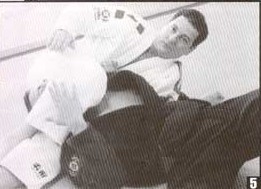Yesterday I was training my side mount escapes. My partner and I repeatedly started with me pinned, and then we worked until I got out or until someone tapped.
Well I got sloppy and ended up on the receiving end of this rather horrendous armlock/choke/neck crank technique that’s one of Marcus Soares’s signature moves.

So there I was, getting squished. I was in pain, but pride kept me from tapping out (which, is, of course the wrong thing to do). I squirmed this way and that, trying to find a way out.
I ended up escaping by the skin of my teeth. I literally had to I ‘walk’ his leg off of my face using my face muscles, alternately contorting my face into a frown, then a manic smile. Frown. Smile. Frown. Smile. Frown. Smile…
Fortunately the combination of luck, determination and desperation eventually paid off and I was out of the submission and out from under side mount.
Not surprisingly, though, my neck was pretty sore that evening. A bad kind of sore. That oh-boy-I’ve-done-it-again kind of sore.
That was yesterday. And today my neck is almost 100% again. So what did I do?
Nowadays almost everybody knows about using the R.I.C.E. formula to deal with sprains, strains, pulls or tears. This 4 step process consists of:
R = Rest (i.e. don’t make it any worse)
I = Ice (10 minutes on, 10 minutes off)
C = Compression (a not-too-tight ACE bandage, for example)
E = Elevation (lifting the injured body part above the level of the heart)
When it comes to neck and back injuries you’re kind of limited though – compression and elevation don’t apply.
You really don’t want to be found unconscious with some sort of band wrapped around your neck – the optics just aren’t good (honest mom, I hurt my neck…). And with regards to elevation it’s hard to elevate your neck above your heart more than it already is.
This leaves us with steps one and two: rest and ice. It’s funny: almost everyone will ice a sore elbow, but very few people apply ice to a sore neck. This is a mistake.
That evening I put a gel ice pack into a sleeve and tied it around my neck, 10 minutes on and 10 minutes off, all evening. The 10/10 rule is important, because it’s easily possible to give yourself frostbite by leaving ice or ice packs on too long.
I even ran an errand with that neoprene sleeve around my neck. Yes, I got some funny looks, but I’m 100% certain that the early and aggressive icing had a lot to do with my quick recovery.
The other tool in the R.I.C.E. formula for sore necks and backs is rest. Notice that it does NOT say ‘stretch’. If you’ve recently strained your neck or back then DO NOT STRETCH IT.
When you strain a muscle it’s typically been slightly torn or damaged. The pain and stiffness is a way for the muscle to protect itself. When you stretch it too early, you’re just aggravating it further.
The worst back pain I ever had is when I came home from work with a very sore lower back and tried to stretch it out. At the end of that (gentle) stretching session I was so seized up that I couldn’t get up off the ground. I lay in the same spot on the floor for 24 hours, wondering if I would ever walk again.
It’s usually OK to start gentle stretching AFTER the inflammation has gone down – typically 3 to 4 days in the case of a mild strain or sprain.
So to summarize: if you strain your back or neck, DO get ice on it right away, but DON’T try to stretch it out.
The post Emergency Rx for Cranked Necks and Strained Backs appeared first on Grapplearts.
